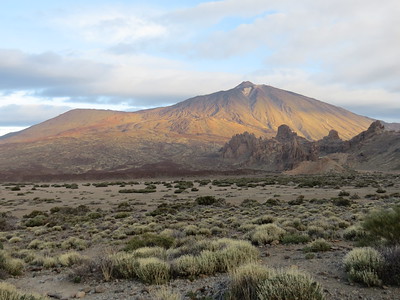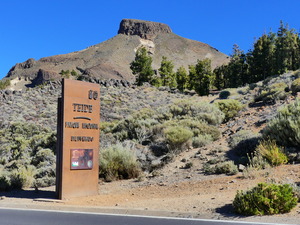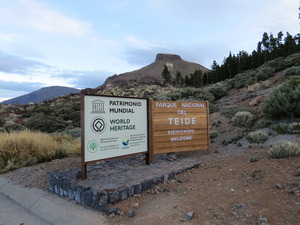Teide National Park

Teide National Park comprises a volcanic landscape in a spectacular setting that stands out in size, complexity, age, depth of study and ongoing relevance to science.
It covers the two large stratovolcanoes of Teide and Pico Viejo, Las Cañadas Caldera and many other volcanic features. At 3,718 m above sea level, Teide Volcano is the third-highest volcano in the world. It is a major centre for international geological research and has been so since the times of Von Humboldt.
Community Perspective: This is a fascinating place to visit for 1 or 2 days, to enjoy the lava flows and contrasting colours in the landscape. Kbecq climbed Mount Teide (in the snow!) and Clyde provides tips for the best viewpoints.

Map of Teide National Park
Community Reviews
Clyde

I visited this WHS in January 2020. I travelled around this WHS by rental car over 2 days using Guía de Isora as my base for 4 nights. This was quite convenient to explore different areas of the Teide NP while at the same time being close to Los Cristianos ferry terminal and South Tenerife Airport.
I had very high expectations for this WHS and I must say I definitely wasn't disappointed. It is a very well kept national park with free access, free parking, free visitor centres and a free botanical garden! The only time I had to pay was for the return Teleferico to the very top (27 eur) which is not at all necessary to still enjoy the OUV of this WHS.
During my visit I was blessed with beautiful sunny weather with temperatures varying from 1-23 degrees Celsius (depending on the altitude). Make sure to check the Teide weather report as it is quite possible to have completely different weather around Teide compared to the rest of Tenerife (most of the time you're likely to be above any cloud cover on Tenerife when visiting Teide NP). Moreover, at night and very early in the morning, it can snow quite a lot, so much so that the main roads can be closed at any given time should the authorities deem this necessary.
Over the course of 2 days, I stopped at practically all the several viewpoints or miradores along the TF-21 and the TF-38 main roads going through and around the Teide NP. At the beginning of both main road, on either direction, there are UNESCO WHS markers (no inscription plaque yet though). Each mirador has a number of different information boards bearing the UNESCO symbol.
The TF-38 main road is by far the busiest in terms of traffic but at no time of the day did I feel the place was overcrowded. The only place where later on in the day, parking and bus loads of tourist groups may be an issue, is at the Roques de Garcia Mirador and La Ruleta parking. Here there's a visitor centre under restoration or under construction and an expensive parador for those who want to actually sleep at the WHS proper. If you visit early in the morning, parking will be quite easy, however even if you visit later on in the day, there are a number of minor miradores or parking points on the side of the road just before the Roques de Garcia mirador. In fact, if you like hiking, I would recommend parking your car at the Mirador Llano de Ucanca (or even Mirador Boca Tauce if you're in for a long return hike) and hiking to Roque Chincado and Roques de Garcia.
At Mirador Boca Tauce, you'll be able to see 2 different types of lava flows from Pico Viejo: AA lava which is quite sharp and jagged and Pahoehoe lava which is much smoother. The Llano de Ucanca is now a sedimentary plain of what was possibly a temporary lake. The variety of landscapes here, together with the breathtaking view of the Teide volcano, make this a highlight of the national park which shouldn't be missed. Just before getting to the colourful hydrothermal alterations of Los Azulejos, you'll be able to gaze at the famous Roques de Garcia (already at an elevation of around 2070m). Most people reaching the Mirador Roques de Garcia will immediately head uphill thinking they'll be able to get a decent shot above Roque Chincado. However, the hike up has been chained off half-way as a safety precaution I suppose, so the best photos in my opinion can be taken just a few steps after the first big rock formation or from the Sendero 3 and 23 hiking trails. With a bit of luck and patience, you'll definitely be able to spot a lot of birds here such as the Canary Island Kestrel, Betherlot's pipit or Southern Grey Shrike.
These incredible rock formations are actually called phonolytic and bifurcated dykes, that is channels from where the magma that fed the different eruptions which took place over time flowed up from. These rocks, which once lay very deep underground, were exposed when the area of Las Canadas was formed. From then onwards, these rocks have been worn away by erosion. The most famous rock is probably Roque Chincado. Its base is disintegrating more quickly than the upper part and eventually it will collapse under its own weight (perhaps this is why in a way it reminded me of the Azure Window which once stood in Dwejra, Gozo).
After quite a longish but satisfying hike, upon returning to the Mirador Llano de Ucanca, I crossed the road and hiked a bit upwards to view another peculiar rock formation known as Zapatilla de la Reina, which can easily be overlooked since you have to give your back to the splendid view of the Teide volcano to notice it.
One of the best miradores and hiking trails on the TF-38 main road, is definitely Mirador Samara. The volcanic cone of the Samara volcano has an interesting crater formed by a single eruption of pyroclasts, i.e. volcanic debris ejected into the air during an eruption. This mountain forms part of the most recent area of volcanic activity in Tenerife. Volcanic bombs can also be observed and on the summit there are nuanced mixtures of colours caused by oxidation. The hiking trail from this mirador allows you to walk among different volcanoes, namely the volcanic cone of the Samara volcano, and the Teide and Pico Viejo volcanoes, in a lovely Canarian pine forest landscape which is slowly taking over the black landscape of Narices del Teide and Los Regatones Negros.
At El Portillo, there's a small visitor centre showing a very interesting video on the Teide national park, and a botanical garden which is always open. It's a great place to spot the beautiful Tenerife blue chaffinch or Pinzon Azul, other finches and woodpeckers. Make sure you follow the Ruta Pinar de la Cumbre loop while walking around the botanical garden.
Close to the Pico del Teide, I was surprised and really happy to spot a flowering Tajinaste Rojo, so remarkable for its spectacular profusion of red flowers usually in Spring. This plant became very rare some 30 years ago when it was commonly eaten by livestock. However, since the banning of livestock grazing in the national park, the species has since recovered. The Tajinaste Rojo shoots can grow as high as 2 metres and around the park I could see several shoot 'skeletons'. Much of Teide's flora adapted to the harsh environment by reducing the size of the leaves, reducing the surface area to maintain constant temperature and humidity within its interior, generating a wax layer over the leaves to reduce water loss, seeking shelter in fissures and small ledges, growing for long periods underground, etc.
All in all, I really enjoyed this great WHS in Tenerife. Judging by how the rest of Tenerife developed and is developing, it certainly is a good thing that the Teide NP has been protected from early on. From all the volcano WHS I visited so far, this must be one of the best, and as a national park it really is world class in terms of size and quality (although I'm really looking forward to visit Yellowstone in the future to be able to compare).
Guy00
Fascinating place on the tourist island of Tenerife. About a 2 hour coach ride up from the seaside resorts. It has moonscape like elements and lots of rock formations around the slopes of the giant volcano. There is a cable car to the top of the volcano from the coach park on the higher slopes, or you can walk up if brave.
Unique environment for plants and insects at such a high altitude with the volcano rising directly from the ocean.
We booked a coach tour from our hotel but you could easily hire a car and drive up as you would have more time to explore and not have 50 people following you in a group.
Tip: take warm clothing as it can be very cold and windy at the top even if it is scorching down in the resorts!
Matejicek

I visited Tenerife in January 2011. I have great memmories on it, because it was a special trip when me and my friend crossed a half of the island by walk overnighting in the wild nature. I am pretty sure that it was not completely legal in National Park. I am also sure that it will never happen to me again, because I am getting older prefering hotels and not prefering heavy backpacks anymore... So, it was a unique experience in all aspects.
We walked from Vilaflor located near the southern edge of Teide caldera. It was for the first time I was in the vulcanic landscape, and I cannot describe properly how I felt when have been climbing Guajara mountain, seeing Teide mountain and the entire caldera for the first time. We refused using "teleferico" to reach the summit of Teide and walked towards Refugio de Altavista, where we have pre-booked an accommodation by phone. We could not climbed the peak because of ice plates that might be dangerous. Then, we walked to the east to Cumbre Dorsal mountain range.
What I loved was all the contrasts: blue sky vs. black basalt rocks such as Huevos del Teide vs. ochre or red soil; sunny days vs. freeze of night; Moon-like landscape vs. green pine forests outside the caldera vs. blue ocean. Furthermore, the color shades of rocks within the caldera changed during the day.
To conclude: Teide National Park embodies one of the most beautiful landscape I have ever seen.
Kbecq

We visited Teide National Park for two days in the autumn.
The first day we went to the 'Roques de Garcia', already mentioned in Els' and Hubert's reviews. We can confirm that during the 3.5km walk, at some points it's easy to lose track of the path. Just keep looking for the small 'stone towers' which indicate the correct way.
The second day we got up early to climb Mount Teide. The best way to do this is to start from the small parking located around kilometer 40 on road TF-21. The trail is about 9km (one way) and first leads you along Montaña Blanca and the impressive 'Huevos del Teide' (lava 'cannonballs' from the eruption of the vulcano).
After some time you will reach the base of Mount Teide. When we visited, the whole track (from the start) was covered with snow which made the way up Mount Teide somewhat difficult. The trail ends at 'La Rambleta' at about 3.500m, which is also the place where you will arrive if you make use of the cable car.
For the last 200-300m to the top, you need a permit. We disposed of such permit (it can be requested online and is free of charge) but because of the snow the summit was closed. However, even from La Rambleta the view is stunning - on the picture you can see Pico Viejo and the island of La Gomera.
As mentioned below, note that at 3.500m it's much colder than at sea level and that some people can start experiencing altitude sickness.
Els Slots

When I told my colleagues that I would be visiting Tenerife during the New Year’s holiday, they thought that I finally had succumbed to a relaxing beach vacation. They were surprised to hear that it would put me within reach of 3 WHS. Those that had been to Tenerife themselves all offered “El Teide” as the island’s most likely WH candidate.
The Teide WHS is a volcanic landscape that actually covers two peaks (Pico Viejo and Teide), of which the latter is the most iconic. I already enjoyed good views of it from the plane while approaching Tenerife Norte Airport, and from the top of the Garajonay on La Gomera.
Teide NP is part of our infamous “One million visitors or more”- connection. Visitor numbers have actually been dwindling over the past 5 years (due to the economic crisis?). Still, it can get very busy up there, and I used Hubert’s excellent advice on how early to start out. I left my hotel in Granadilla at 7.30 a.m. When I arrived at the park some 45 minutes later, it was almost freezing cold (+2.5 Celsius) but I had the place to myself. Just wonderful.
I stopped at a few Miradores, watching the sunrise. Comparisons to the moon have been made, but the landscape looked more like Southwestern USA to me. It’s not that barren: tough plants cover large parts of the ground. The most prominent spot here at the southern side of the park is the Roques de Garcia. This is a series of strangely shaped rocks, the erosional remnants of an earlier version of the volcano. There’s a 3.5 km long trail that loops around them. Although the temperature left me with very cold hands, I opted to do this medium-level hike and see the rocks up and close.
The path starts out easy but gets more tricky halfway. You actually walk along the back-side of the rocks. I even got lost a bit, I was starting to scramble up a hill when I saw 2 people approaching from the other side showing the right path. The real climb is left to the end, a switchback trail all the way up to the main viewpoint again. That trail is where I got the best views, including that of the photo right above.
After the hike, I drove down the road that cross-sects the park. There are a couple more viewpoints, but none I found as spectacular as the Roques. I already had decided beforehand to forego the cable car ride to the top. The visitor center “El Portillo” at the northern end of the park turned out to be closed on January 1st. It was free to enter the attached botanical gardens though, where I was immediately attracted to another view of the Teide.
Teide NP entered the WH List in 2007, at the same session as Korea’s Jeju Island. This sparked a debate if there weren’t enough volcanoes on the list already (“including several properties whose inscription was justified on the basis of arguments that are considered by a number of experts to be rather narrow”). The Committee requested IUCN to do a Thematic Study. The results were publicized in 2009: although most types of volcanic features were considered well-represented, some gaps were still identified.
Since 2009 several new volcanic sites have been added to the List (Pitons of Réunion, Ogasawara Islands, Mt. Etna and Mt. Fuji for example) - not the ones that would fill any lacunes. And although the IUCN study does criticize the “the haphazard process of site selection and nomination of World Heritage properties by State Parties”, it doesn’t dare to say which of the already inscribed ones are superfluous. No doubt has ever been cast about El Teide: its height, age (over 3.5 million years) and gigantic caldera (a term that originated here) justify its inscription.
Hubert

In November 2007, we spent one week on Tenerife to escape the cold weather in Austria. We visited the Mount Teide National Park as a day trip from our accommodation at the south-west coast. We started early in the morning (at 7am) with our rental car in order to avoid the large tour buses, which start between 8 and 9 am from all major tourist centres. Another reason to get up early is that in the morning the air is clearer and the view is better, in the afternoon the Teide summit could often be hidden by clouds.
We took the road via Guia de Isora and arrived at the National Park after about 1.5 hours. The route is very interesting, you drive from sea level to 2,300 meters through different vegetation zones. First everything is green and colourful, we drove through banana plantations, followed by pine forests, and finally we arrived at the caldera Las Canadas, where rocks and solidified lava flows predominate. It reminded me of pictures from the Moon or Mars. Early in the morning we were almost alone on the road, so that we could stop everywhere to look around and to take pictures.
The most popular and most spectacular viewing point is the Roques de Garcia, opposite are a Hotel Parador and an information centre. The Roques are bizarre, unique rock formations. Plenty of needle-shaped rocks of different colours stand one after another at a length of several hundred meters. The rocks consist of different layers from various eruptions. And you have a beautiful view over the caldera with Mount Teide in the background (photo: Roque Chinchado). Starting at the visitor centre, we hiked along a well-marked path for about 2 hours through the lava field. I was surprised how varied this "moonscape" is: lots of red and brown colour tones, bizarre rock formations, and all together with a bright blue sky. When we returned from our hike, we were glad that we got up so early. The parking lot at the Roques was crowded with cars and tour buses.
A few kilometres further, a side road leads to the base station of the cable car to Mount Teide. But we drove on to the northern end of the National Park without a ride to the summit. The cable car ends at an observation deck, the summit is inaccessible without permission. Approval is given only in the main office of the National Park Service in the capital Santa Cruz. We came to many more interesting places that were worth a brief stop: beautiful views of the caldera and the Teide and places where you can see endemic plants like Tenerife bugloss or broom.
All in all, it was a rewarding trip to an exceptional landscape. If you are on Tenerife, you should not miss the Teide National Park.
.
This is one of the 14th Spanish National Parks and it is located in the island of Tenerife. It comprises the Mount Teide, highest mountain in Spain, and some areas around it.
I did not try to climb the Mount Teide till the top when I was there but it does not seem to be a very hard task. Just take into account that the summit is at almost 4000 meters therefore lack of oxygen can be a problem. You should also take into account that all the territory of the National Park is over 2000 meters high therefore weather can be quite different than in the rest of the island.
Landscape in Teide National Park is vulcanic and there are some endemic plants living there. Inside the Park there is one Parador, that would be a very good choice to stay as hotels of this group are among the best and most charming ones in the country.
Community Rating
- : Luis Filipe Gaspar Inigo Cia George Gdanski Christoph Ailton007 Cezar Grozavu GZ WalGra HannahJoergensen Mikeyboyracer Bropyk Kokoro MH Forest80 Max Disnsam Adolfo
- : Szucs Tamas Clyde MoPython Ih0000 Mohboh Matejicek Argo Rodinia Shoaibmnagi VB73
- : Zoë Sheng Solivagant Craig Harder Nan Joyce van Soest Philipp Peterer Ivan Rucek Csaba Nováczky Roel Sterken Tarquinio_Superbo Guy00 Nycelle Tevity Walter Alex Marcean Alikander99 CeeMon Els Slots
- : Gary Arndt Alexander Lehmann Philipp Leu Chessjsr Svein Elias Dorejd Shandos Cleaver Travel Addicts Hubert Wojciech Fedoruk Viaje al Patrimonio JoStof ChrisN Jeanne OGrady Sturuss Smeets Peter JLuth Lukemarshall Martina Rúčková
- : Peter Lööv Randi Thomsen HaraldOest Giulio25 Groundgefluester
- : Peter Alleblas
- : Adrian Turtschi
Site Info
Site History
2007 Inscribed
Site Links
Unesco Website
Official Website
Related
Locations
The site has 1 locations
Public transport is limited to about 1 bus per day. Organized bus tours can be taken from the coastal areas. Overall, your best bet is a rental car. The park is accessible by minor but paved roads from all sides. A public road runs from northeast to southwest across the caldera.
Connections
The site has 38 connections
Constructions
Ecology
Geography
History
Human Activity
Individual People
Literature and Film
Religion and Belief
Science and Technology
Timeline
Trivia
WHS Names
WHS on Other Lists
World Heritage Process
Visitors
276 Community Members have visited.

